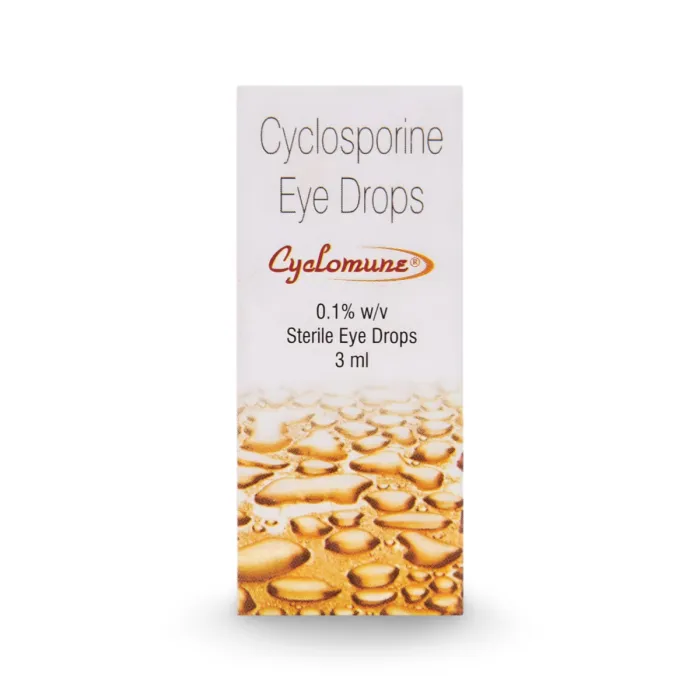
Cyclomune 0.1% 3 ml
| Pack Size | Price | Qty | Unit Price |
|---|---|---|---|
| 1 Bottle/s | $13.80 | $13.80 | |
| 3 Bottle/s | $32.70 | $10.90 | |
| 6 Bottle/s | $58.40 | $9.73 |
What is Cyclomune 0.1
Cyclomune 0.1 containing Cyclosporine, is an immunomodulatory agent primarily used to treat dry eye disease (DED) and other inflammatory ocular conditions. This medication belongs to the drug class of Calcineurin inhibitors, which increase tear production and reduce inflammation. By enhancing tear production and improving the health of the ocular surface, it reduces symptoms such as burning, irritation, and discomfort.
Cyclosporine, is an immunosuppressant that reduces the immune response, specifically targeting T-cells. By decreasing the levels of inflammatory substances, Cyclomune helps relieve symptoms of dry eyes, such as irritation and discomfort, allowing for better lubrication and overall eye health.
Potential side effects include ocular burning, redness, tearing, and foreign body sensation upon instillation. It is essential for patients with a history of Herpes Keratitis to consult their healthcare provider before using this medication due to its immunosuppressive properties, which could exacerbate viral infections.
Cyclomune eye drops may interact with other medications that affect immune function or ocular health. Patients should inform their healthcare provider about all medications they are taking to avoid adverse interactions. The use of other immunosuppressants concurrently with Cyclomune may increase the risk of infections or reduce the effectiveness of treatment.
This medication was manufactured and marketed by Sun Pharmaceutical Industries Ltd.
What are the benefits of using Cyclomune 0.1
Cyclomune 0.1% benefits patients suffering from dry eyes and related conditions. It is primarily formulated to increase tear production, relieving those who have not found improvement with conventional artificial tears.
By reducing inflammation in the eye, Cyclomune helps alleviate discomfort associated with dry eyes, such as redness, irritation, and a gritty sensation.
This medication effectively treats conditions such as severe keratitis, a cornea inflammation that can arise from chronic dryness.
How to Use Cyclomune 0.1
The directions for using Cyclomune 3 ml are as follows:
- Use this eyedrop in the dose and duration as your doctor advises. Typically, it is used twice a day, once in the morning and once in the evening, but your doctor may suggest using it according to your symptoms and severity.
- Wash your hands thoroughly before using the eye drops. Hold the dropper close to your eye without touching it. Gently squeeze the dropper and place the medicine inside the lower eyelid. Wipe off any extra liquid. Close your eyes for 1 to 2 minutes.
- After taking the medication, apply pressure to the corner of the eye (close to the nose) for about one minute to prevent the medication from draining out. Do not blink or rub your eyes.
- Remove your contact lenses (if applicable) at least 15 minutes before using the medication. The same goes for putting them back. Don’t overdose on this medication.
Strengths and Substitutes
Cyclomune eye drops come in various strengths and substitutes, some are available on our site. Your doctor will prescribe the strength of medication required to treat your problem.
The following substitutes are available for the Cyclomune eye drop:
| $8.00 / bottle |
What are the side effects of Cyclomune 0.1
The directions for using Cyclomune 3 ml eye drop are as follows:
- Eye irritation or Itching
- Dry eyes
- Blurred vision
- Eye redness
- Eye discomfort
Cyclomune eye drop may cause some side effects. These adverse effects are temporary and will subside as your body adjusts. Seek medical assistance if the side effects persist or worsen.
Safety advice
Cyclomune 3 ml eye drop has not been shown to have adverse effects in patients with liver conditions, so it is safe for use. However, it is recommended that you seek medical advice from professionals.
People with kidney problems can use these eye drops, as they have no known effects on kidney function. However, it is recommended that they seek medical advice from professionals.
Limited data on its safety during pregnancy exist. However, it is recommended that this medication not be used or prescribed by a healthcare provider during pregnancy. It has no known adverse effects on breastfeeding women.
Take your doctor's advice before consuming alcohol with Cyclomune eye drop, as it might impact the effectiveness of medicine. Remove soft contact lenses while using this medication, as it might discolor the lens.
FAQs
Is Cyclomune a steroid eye drop?
No, Cyclomune is not a steroid eye drop. It contains Cyclosporine, which decreases inflammation in the eye and increases tear production. Cyclomune is primarily used to treat dry eyes, not as a steroid.
Does Cyclomune eye drop 3 ml cause blurred vision?
Yes, Cyclomune eye drops can cause blurred vision as a common side effect. This temporary effect may occur immediately after application. Users should avoid driving or operating heavy machinery until their vision clears. If blurred vision persists, consult a healthcare professional for further guidance.
Can I wear a contact lens while using Cyclomune eye drops 3 ml?
Yes but remove contact lenses before using Cyclomune 3 ml eye drops. After applying the drops, wait at least 15 minutes before reinserting the lenses to ensure proper absorption and avoid irritation. Always follow your healthcare provider's instructions for the best results.
Can I use other eye medications with Cyclomune eye drops 3 ml?
Yes, you can use other eye medications with Cyclomune eye drops, but it is essential to maintain a 15-minute gap between applications. This allows each drug to be absorbed effectively without interference. You should always consult your doctor for personalized advice regarding specific medications.
Can Cyclomune eye drops 3 ml help reduce conjunctivitis?
No, Cyclomune helps with inflammation-related symptoms such as dry eyes and increases tear production. But it does not directly interact with the underlying causes of conjunctivitis, which often requires different treatments, such as antibiotics for bacterial infections.
{{title}}
{{{detail}}}
{{#adminComment}}